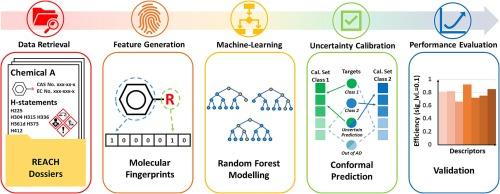Prediction of the classification, labelling and packaging regulation H-statements with confidence using conformal prediction with N-grams and molecular fingerprints
IF 2.9
Q2 TOXICOLOGY
引用次数: 0
Abstract
Effective chemical hazard labelling systems are essential for safeguarding human health and the environment as a result of widespread chemical use, and machine-learning models can be used to predict hazard labels efficiently and reduce the use of animal tests. This investigation shows the utility of N-grams and other fingerprint featurization procedures for predicting classification, labelling and packaging (CLP). Regulation H-statements, particularly in an ensemble (consensus) setting. Consensus modelling by class or Conformal Prediction median p-values seems to be particularly advantageous in order to obtain both high conformal prediction validity and efficiency as well as good balanced accuracy, sensitivity and specificity. Utilization of the N-grams allows handling of all symbols in SMILES strings including those related to metals and salts that may be important for the compounds to exhibit their experimental determined toxicities. The models developed in this study are efficient tools to access hazard classification H-statements of chemicals, which can be useful for chemical hazard assessment, read-across as well as risk management.

利用n -图和分子指纹的保形预测对分类、标签和包装法规h -陈述进行预测
由于化学品的广泛使用,有效的化学品危险标签系统对于保护人类健康和环境至关重要,机器学习模型可用于有效预测危险标签并减少动物试验的使用。本研究显示了n -图和其他指纹特征程序预测分类,标签和包装(CLP)的效用。规则h声明,特别是在整体(共识)设置中。为了获得高的适形预测效度和效率,以及良好的平衡准确性、敏感性和特异性,采用类别或适形预测中位数p值的共识建模似乎特别有利。利用N-grams可以处理SMILES字符串中的所有符号,包括与金属和盐相关的符号,这些符号可能对化合物展示其实验确定的毒性很重要。本研究建立的模型是获取化学品危害分类h表的有效工具,可用于化学品危害评估、解读和风险管理。
本文章由计算机程序翻译,如有差异,请以英文原文为准。
求助全文
约1分钟内获得全文
求助全文
来源期刊

Current Research in Toxicology
Environmental Science-Health, Toxicology and Mutagenesis
CiteScore
4.70
自引率
3.00%
发文量
33
审稿时长
82 days
 求助内容:
求助内容: 应助结果提醒方式:
应助结果提醒方式:


